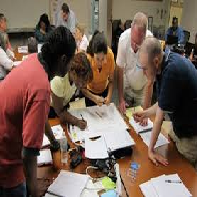The Developmental Foundation for Teaching and Learning Order Instructions:

For this assignment, you will investigate and reflect on learning theories that provide the developmental foundation for teaching and learning. You will consider the work of Jean Piaget, Lev Vygotsky, and Erik Erikson.
At age 11, Jean Piaget wrote and published his first scientific paper featuring the albino sparrow. He was a brilliant scientist revered by many and is best known for his research on cognitive development. As you read about Piaget, ask yourself how the stages apply to your classroom, workplace, or family. You will need to focus on concrete operations, identity, compensation, reversibility, classification, seriation, adolescent egocentrism, formal operations, etc. You should select any topic appropriate to your life, family, or workplace.
Lev Vygotsky was a tormented, frustrated young teacher in Russia. Desperate for answers to improve his teaching, he began seeking answers by studying learning and development. He swiftly became a recognized researcher but was banned in Russia because of his references to Western psychologists. His all-too-brief life yielded a treasure trove of remarkable research on the sociocultural perspective we continue to use today. Vygotsky’s ideas about language, culture, and cognitive development continue to be major influences in socio-psychology today.
Erik Erikson was an interesting enigma of a researcher who sought answers as much for himself as for others. Born an illegitimate child in Frankfurt, Germany, the product of a married man and single mother, he spent his life focused on researching one’s identity. His parents kept his identity secret, but he was tormented at temple school for being tall, blonde, and blue-eyed and teased at grammar school for being a Jew. During his early professional life, he became acquainted with Anna Freud, the daughter of Sigmund Freud; there began his exposure to and learning of psychoanalysis. He also studied the Montessori Method of education while in Vienna. When the Nazis came to power in Germany in 1933, he and his wife immigrated first to Denmark and then to the United States, where he became the first child psychoanalyst in Boston. It is important to note that he and his wife spent a year on a Sioux reservation in South Dakota as he developed his theories of child development and the ego. Erikson developed the Eight Stages of Psychosocial Development. As you read, reflect on Erikson’s stage progression and your own life, noting transitions, changes, and new developments. See if Erikson’s theory correlates to your experience!
Choose one of the three theorists— Piaget, Vygotsky, or Erikson—and address the following:
• Choose the most compelling and personally or professionally relevant concept the theorist has to offer.
• Share examples of how you have implemented or plan to implement strategies derived from this theorist in your personal or professional life.
The Developmental Foundation for Teaching and Learning Sample Answer
The contemporary developmental foundation for teaching and learning has significantly been boosted by the various learning theorists. The learning theory by Lev Vygotsky focuses majorly on social development. It forms the necessary foundation that focuses on constructivism. It suggests that the existence of three major themes that involve social interactions, the more knowledgeable other and finally the zone of proximal developments as key concepts. Social interaction concept plays a valuable duty in the entire process of cognitive development of a child. Therefore, understanding a child’s development becomes critical (Metraux, 2015).
He suggested that social learning comes before education and therefore the child’s development is observed firstly through a social level and on the individual basis. The concept of the more knowledgeable other refers to a state of exhibiting more knowledge, abilities or better understanding than the learner regarding any concept being taught (Metraux, 2015). The idea suggests that an individual that exhibits the above qualities might be a teacher, instructor, coach or even young peer. The final concept of Vygotsky’s theory is the zone of proximal development which refers to the gap between the ability of a learner to do a particular duty under the control and guidance by the adult leading to the occurrence of learning. He suggested the significance of having internalization of techniques like speech and writing are developed through people’s connections and the social-cultural aspect.
In my profession, I have applied Vygotsky’s theory in the transmission of knowledge to the students through the aid of instructions model primarily because I exhibit more knowledge than the student. I have promoted learning among students when I involved them in learning through discussions which are a concept of Vygotsky’s theory which suggests the collaboration between the instructor and the students to enable meaningful learning and development (Metraux, 2015).
To sum up, Vygotsky’s theory provides a foundation for learning since it promotes learning among students through their active participation leading to meaning construction among students.
The Developmental Foundation for Teaching and Learning Reference
Métraux, A. (2015). Lev Vygotsky as seen by someone who acted as a go-between between eastern and western Europe. History Of The Human Sciences, 28(2), 154-172. doi:10.1177/0952695115575410




